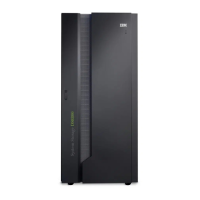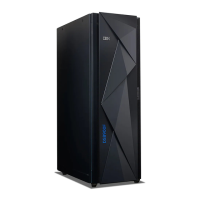Note: When incremental resynchronization is started, there is a short period of
time where a full volume copy is required. This occurs because incremental
resynchronization has not fully initialized.
Overriding incremental resynchronization function checking
You can override (or bypass) system verification to avoid checking if relationships
exist between the volumes in a Metro/Global Mirror configuration. Issue the
mkpprc -incrementalresync override command to override the system verification.
When the command processes, only changes on the Metro Mirror A volumes that
have the change recording mechanism started are copied to the C volumes at the
remote site. Therefore, you must ensure that the specified volumes have the
intermediate volumes in common before processing the command.
You might want to override a relationship verification in specific scenarios. For
example, you might have a circumstance where the intermediate site is operational.
If this is the case, it is not required to verify whether former relationships exist
when you want to return to the original volume pair relationships in the cascading
Metro/Global Mirror configuration.
Stopping the incremental resynchronization function
You can stop incremental resynchronization for the specified Metro Mirror A
volumes in a cascaded Metro/Global Mirror relationship. Issue either the mkpprc
-incrementalresync disable command or the rmpprc command at the DS CLI
command prompt.
Path connections
Before you can create source and target remote mirror and copy pair relationships,
you must establish logical paths between a logical subsystem (LSS) in a source
storage unit and an LSS in a target storage unit.
When you implement a remote mirror and copy configuration, the definition of
paths that remote mirror and copy uses is an important consideration. To establish
paths, you must have Fibre Channel Protocol (FCP) adapters on both the source
and target storage unit for the peer-to-peer links. Paths are required for
communicating between volume pairs and for copying data from a source volume
to a target volume.
You can establish FCP paths to connect to a source LSS and a target LSS that
contain count-key-data (CKD) or fixed block (FB) volumes. The requirement is that
both the source LSS and target LSS must contain the same type of volumes.
You can define from one to eight FCP paths, depending on the capability of the
LSS, from a single source site LSS to a specific target site LSS.
When you establish remote mirror and copy paths over FCP links, the source
storage unit uses a worldwide port name (WWPN) to communicate with the target
storage unit. The worldwide node name (WWNN) and system adapters
identification (SAID) of the source and destination adapters are used to generate a
WWPN. A WWPN consists of exactly 16 hexadecimal digits. The hexadecimal
characters are 0–9, a–f, and A–F. The values for the WWNN and the WWPN must
be unique.
Chapter 8. Optional feature codes for the DS8000 129

